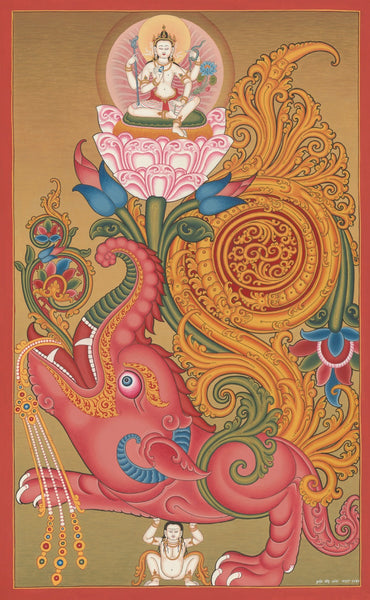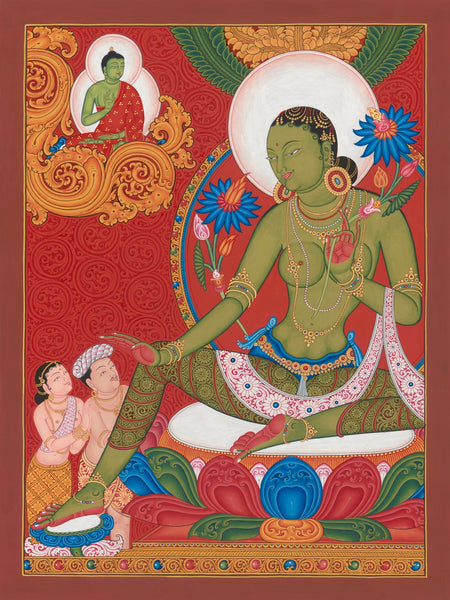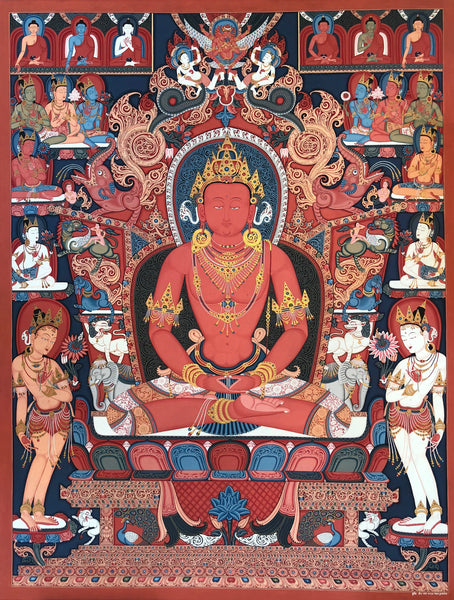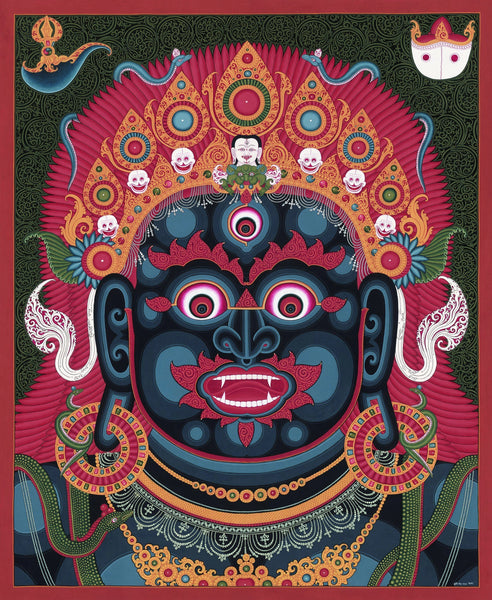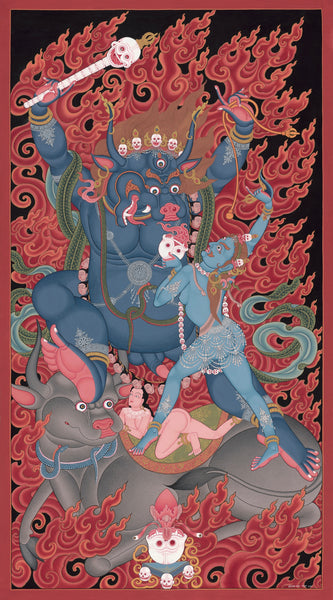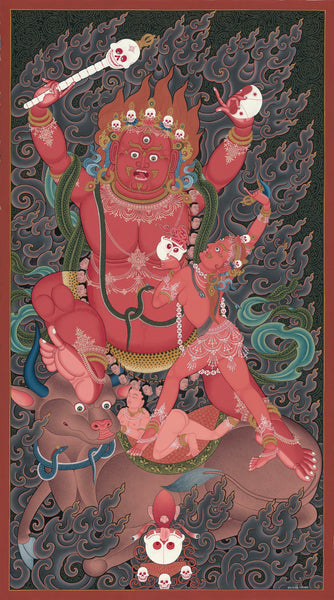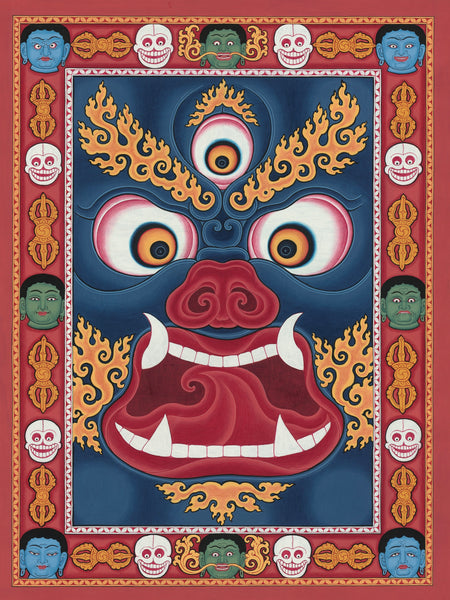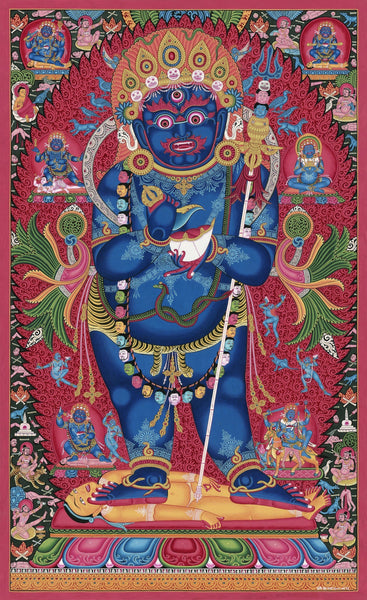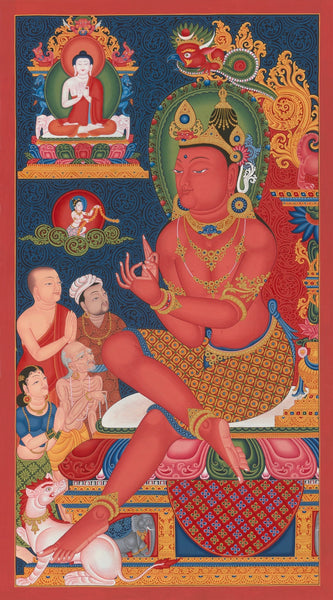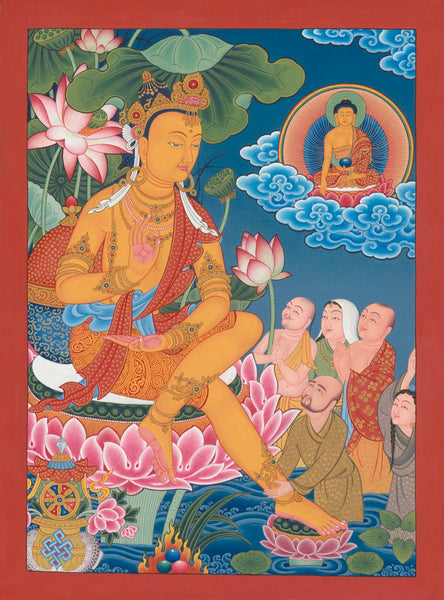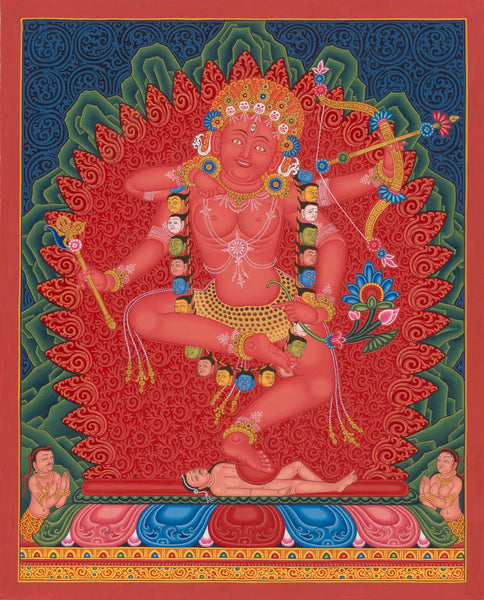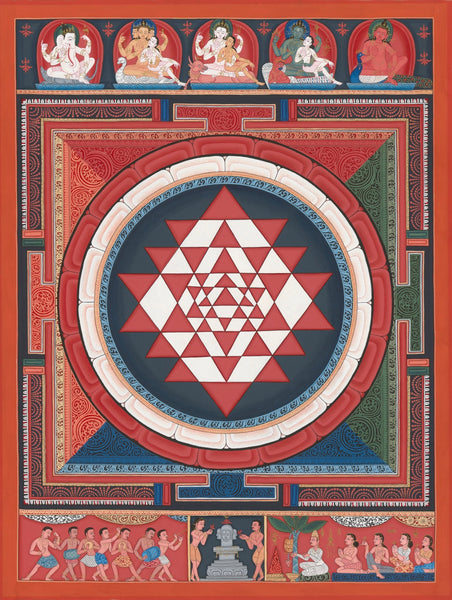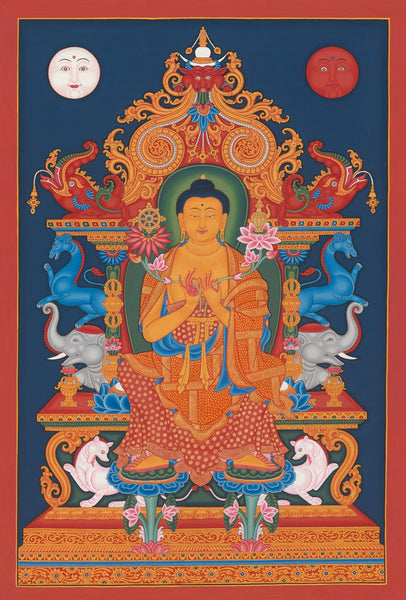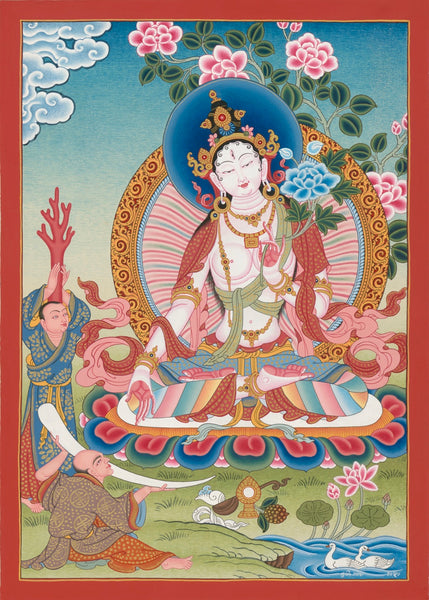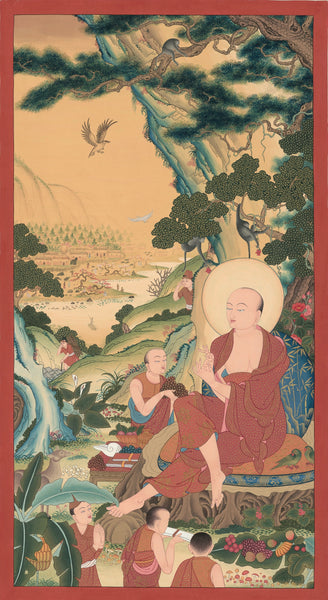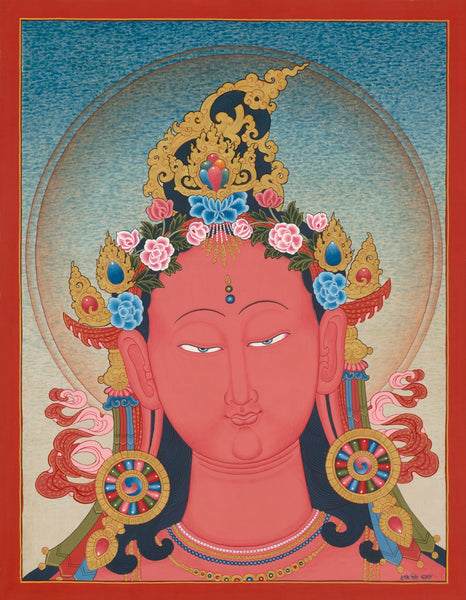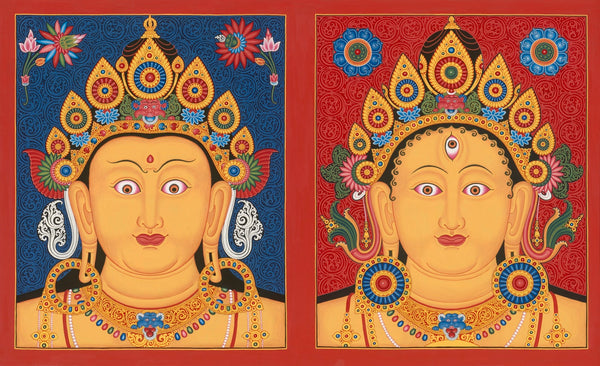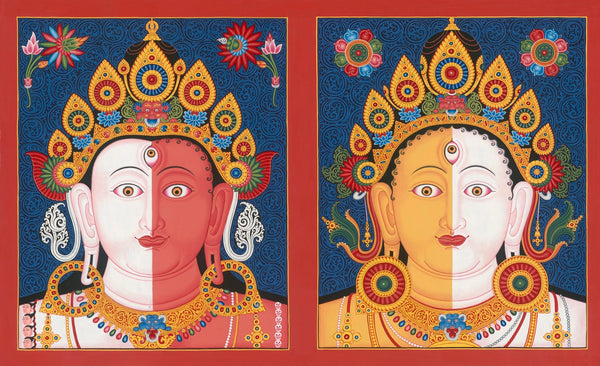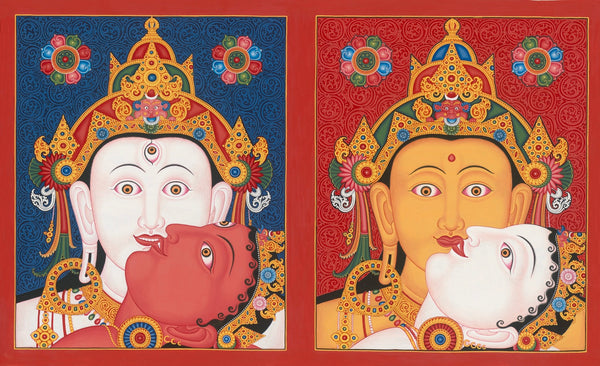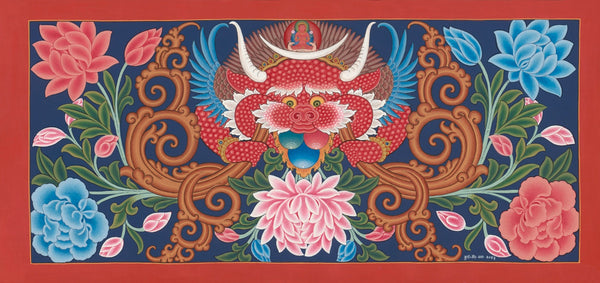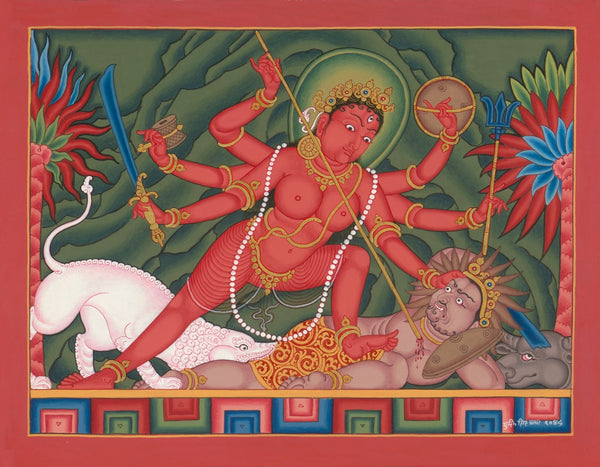MUKTI SINGH THAPA'S 'EARLY COLLECTION'
The first time we heard about this collection was a few years ago. The master Nepali artist, Mukti Singh Thapa, mentioned it casually as we sipped masala tea at his leafy home in Patan, suggesting that he had left a few paintings in Seattle in the early 1990’s.

In the mid-1970s, Mukti was learning his craft after moving to Kathmandu from the small hill town of Bandipur that overlooked 8,156 meter Manaslu and the Himalayan skyline. After several years toiling as an apprentice, Mukti was first recognised by winning the Grand Prize at the National Art Competition. This was 1977 and Mukti had just turned twenty.
Shortly after winning this award, Mukti was invited to have a one-person exhibition at the Oriental Hotel in Bangkok. This was his first international show. As the 1980s dawned, Mukti’s acclaim increased among American scholars, collectors and galleries. He was invited to the US in 1989 for his first American tour. He visited Santa Fe, Philadelphia, Boston and New York and his art was met with awe. Art lovers who were unfamiliar with thangka, or paubha, paintings couldn’t believe that his works were painted by hand.
He returned to the US in 1993 for additional exhibitions in Cleveland, Michigan, Atlanta and Seattle. Mukti’s international recognition grew as he had a show at the Nicholas Roerich Museum in New York City (1992), was featured in the ‘Art of Microsoft’ exhibition in the Henry Art Gallery in Seattle (1993), and had works from the collection of Shelley and Donald Rubin displayed at the Oglethorpe University Museum of Art in Atlanta (1994).
Following this final exhibition, Mukti left his paintings with his dear friends, Russell and Barbara Johnson in Seattle (Mukti's photo above is by Russell). He planned to incorporate this art into his next American tour. But this tour never came.
Twenty-five years passed and we were planning a trip to Seattle last year. We reached out to Mukti and he thought it a wonderful idea if we could pick up his paintings. We met Mukti’s friends and shared wonderful stories of Mukti’s warmth and hospitality. Clearly, Mukti is loved far and wide.
Then they pulled out a large tube of art and started showing us the collection piece by piece. Mukti had told us that there were ‘a few’ paintings. There were twenty-three fabulous works of art!
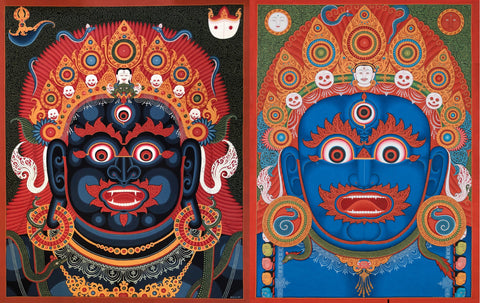
We could not hide our excitement. The collection spanned small pieces to large masterpieces. We have seen many of Mukti’s paintings from the 21st century, but this collection extended the story. Now we could see Mukti’s long professional career, stretching over thirty years. We could see his development as an artist, from his youthful energy to master craftsman. Looking at similar subjects from early in his career to later (see two Mahakala Heads from 1989 and 2015), it is fascinating to see the change.
What is also intriguing is the progression of how Mukti has signed his work. His older pieces are often not signed at all, as was the custom for religious art. Patrons were interested in the gods depicted, not in the artists, and did not want the painting sullied by a signature. Other pieces in this collection are signed in Nepali script as Mukti primarily had a domestic audience in the 1980s. It was only in the 1990s, as he gained interest in Western markets, that Mukti started to sign his artwork in English.
As a traditional artist, Mukti has stayed true to age-old painting techniques. He uses hand-ground mineral pigments such as lapis lazuli, azurite and ultramarine for blues, cinnabar, vermillion and lac (an insect) for reds, orpiment for yellow, chalk for white, carbon for black, and 24 carat gold. These pigments are applied to cotton canvas that has been gessoed with white clay or chalk and natural animal glue, then polished smooth by hand with a river stone. This hardens the canvas and also produces a smooth surface to paint the fine details of these works. These methods are labor intensive and seldomly used by today’s artists, but Mukti and a few other masters still employ them to produce other-worldly artwork.
We hope you enjoy this remarkable collection of Mukti Singh Thapa's 'Early Collection' as much as we do. We will be sharing all twenty-three paintings over time, and are starting with these six stunning pieces.
To see Mukti Singh Thapa's entire collection spanning the 1980s to today, visit his gallery. Please write to us at Mahakala@MahakalaFineArts.com should you have any questions about Mukti Singh Thapa and his sensational art.
Hitimunga by Mukti Singh Thapa (Original Only)
Price on Request
This dazzling painting by master artist Mukti Singh Thapa is of a Hitimunga, or Makara in Sanskrit. It is part of Mukti's 'Early Collection' and, completed in 1984, one of the oldest pieces we have in the collection. As with all of the artist's work, it is painted in the traditional manner with mineral pigments on cotton canvas. The red body is painted with cinnabar and the jewelry is painted painstakingly with 24 carat gold.
The hitimunga, in Newari, is a mythical animal and is depicted in various ways. Typically, it has the lower jaw of a crocodile, the snout or trunk of an elephant, the tusks and ears of a wild boar, the darting eyes of a monkey, the mane of a horse, the paws of a lion, and the swirling tail feathers of a peacock.
The Newar art of Nepal uses the hitimunga extensively. In addition to appearing often in paubha, or thangka paintings, you will find it frequently in Newar architecture. It is found carved into wood and stone on temples and is often used as a water spout with water coming directly out of its mouth.
The artist has placed Varuna, the God of Water, at the top of the painting, as the hitimunga is his mount. At the bottom is a naga, taking the human form rather than that of a serpent.
The original thangka, or paubha, painting, is available for the astute collector. If you are interested in this original painting, please email Mahakala@MahakalaFineArts.com and we will share the price as well as more information about this unique piece.
Early Green Tara by Mukti Singh Thapa (Original Only)
Price on Request
This lovely painting by master artist Mukti Singh Thapa is of Green Tara, the Buddha of enlightened activity, and is part of Mukti's 'Early Collection.' Tara is the most important goddess in Buddhism and was born from Chenrezig Avalokitesvara's tears of compassion. Green Tara protects practitioners from the eight fears.
Mukti painted this work in the late 1980s or early 90s. It is not dated or signed, as is the custom when painting religious works. This is because the practitioner is worshipping the diety and the artist's signature is a distraction from that focus.
It is very interesting to compare this work to our other Green Tara thangka, painted in 2007. In the late 80s Mukti was starting to design a new style that turned the diety to the side, rather than facing forward, opening the painting and allowing it to tell a story. In this older work, Green Tara is in a meditative pose with two followers, and Amoghasiddhi Buddha in the top left.
As with all of the artist's work, it is painted in the traditional manner with mineral pigments on primed cotton canvas. The green body is painted with malachite and the red background is cinnabar, while the jewelry is painted painstakingly with 24 carat gold.
The original thangka, or paubha in Nepal, painting, is available for the curious collector. If you are interested in this original artwork, please email Mahakala@MahakalaFineArts.com and we will share the price as well as more information about this unique piece.
Newari Amitabha Buddha by Mukti Singh Thapa
$435.00
This work by master artist Mukti Singh Thapa is of Amitabha, the Buddha of Immeasurable Life and Light. This historical painting is part of Mukti Singh Thapa's 'Early Collection' and was completed in 1990. Amitabha symbolizes mercy and wisdom and reigns over Sukhavati, or the Western Pure Land. Eight bodhisattvas are in the background with the white Avalokiteśvara and yellow Manjushree on either side, and five goddesses, Pancha Raksha, on the bottom. This stunning thangka is painted in the Newari style of the 16th century and displays Thapa's mastery of this period through its rich color palette and expert use of traditional iconography.
This original thangka, or paubha in Nepal, is painted in the traditional manner with ground mineral pigments on primed cotton canvas. Here, Amitabha is painting with brilliant red cinnabar. The gold ornaments, such as the crown and jewelry, are painted painstakingly with 24 carat gold. A painting of this size will take several months to compose, sketch and complete.
Although the original painting has sold, Mahakala Fine Arts has produced a Collector's Edition print so that you can collect this museum quality work of art. This piece is limited to 100 prints and can only be found at Mahakala Fine Arts. It is printed on thick archival paper in the same professional quality used by top museums worldwide.
With your 113 cm (44.5 inch), 80 cm (31 inch) or 50 cm (20 inch) prints you will receive an authentication card, signed by the artist in English and Nepali script, as well as an artist biography.
Mahakala Fine Arts donates a portion of all print sales to social programs in the Himalaya. Please join us!
Banepa Mahakala Head by Mukti Singh Thapa
$495.00
This outstanding painting by master artist Mukti Singh Thapa is of Mahakala, the Protector of the Dharma. It is inspired by the famed Mahakala, or Bhairab, of Chandeshwori temple in Banepa, Nepal. Banepa is a charming historical town located about twenty-five kilometres east of Kathmandu. Mukti painted this work in 1989 from mineral pigments and it is part of his 'Early Collection.'
Mahakala is considered to be the fierce and powerful emanation of Avalokiteshvara, the Bodhisattva of Compassion. He defends the Dharma from hostile forces and protects the individual practitioner from deception and delusion, bestowing power to overcome life's struggles. This stunning piece displays Thapa's mastery of the 13th - 16th century Newar Design style through its rich color palette and use of traditional iconography.
This original thangka, or paubha in Nepal, is painted in the traditional manner with ground mineral pigments on primed cotton canvas. The stunning blue is painted with lapis lazuli from Afghanistan and the gold ornaments, such as the crown and jewelry, are painted painstakingly with orpiment. A painting of this size and complexity will take several months to compose, sketch and complete.
The original 79 cm (31 inch) painting is available for a special collection. Additionally, Mahakala Fine Arts has produced a Collector's Edition fine art print so that you can collect this museum quality work of art. This piece is limited to 100 prints and can only be found at Mahakala Fine Arts. It is printed on thick archival paper in the same quality used by top museums worldwide.
With your 68 cm (27 inch) fine art print you will receive an authentication card, numbered signed by the artist in English and Nepali script, as well as an artist biography.
Mahakala Fine Arts donates a portion of all print sales to social programs in the Himalaya. Please join us!
If you are interested in the stunning original painting, please email Mahakala@MahakalaFineArts.com. Please note that the listed price ($999,999) on the website is just a placeholder. We will share the price on request as well as more information about this fabulous painting.
Yamantaka by Mukti Singh Thapa
$550.00
This striking painting by master artist Mukti Singh Thapa depicts Yamantaka, the wrathful protector who assumes this form to vanquish Yama, the God of Death. By defeating Yama, the cycle of rebirths, samsara, that prevents enlightenment is broken. Yamantaka is the ferocious aspect of Manjushri, the Buddha of Wisdom, and the red flames represent wisdom. This stunning piece displays Thapa's mastery of the Tibetan style through its beautiful colors, precise lines and traditional iconography.
This painting is part of Mukti's 'Early Collection' and was completed in 1991 when the artist's work was just gaining international acclaim. As with all of the artist's work, it is painted in the traditional manner with mineral pigments, crushed by hand, on primed cotton canvas. The brilliant blue is lapis lazuli from Afghanistan and the rich red flames are cinnabar. The gold crown and other ornaments are painted painstakingly with 24 carat gold.
The original thangka, or paubha, painting is available for the appreciative collector. Additionally, Mahakala Fine Arts has produced a Collector's Edition fine art print so that art lovers can enjoy this museum quality work of art. This piece is limited to 100 prints and can only be found at Mahakala Fine Arts. It is printed on thick archival paper in the same professional quality used by top museums worldwide.
With your 80 cm (31.5 inch) fine art print you will receive an authentication card, numbered and signed by the artist in English and Nepali script, as well as an artist biography.
Mahakala Fine Arts donates a portion of all print sales to social programs in the Himalaya. Please join us!
If you are interested in the original painting, please email Mahakala@MahakalaFineArts.com. Please note that the price ($999,999) on the website is just a placeholder. We will share the price on request as well as more information about this stunning painting.
Rakta Yamari by Mukti Singh Thapa
Sold Out
This striking painting by master artist Mukti Singh Thapa depicts Rakta Yamari. This stunning piece displays Thapa's mastery of the Tibetan style through its beautiful colors, precise lines and traditional iconography.
This painting is part of Mukti's 'Early Collection' and was completed in 1991 when the artist's work was just gaining international acclaim. As with all of the artist's work, it is painted in the traditional manner with mineral pigments, crushed by hand, on primed cotton canvas. The rich red is cinnabar. The gold crown and other ornaments are painted painstakingly with 24 carat gold.
The original thangka, or paubha, painting has sold. If you are interested in another original painting from our extensive collection, please email Mahakala@MahakalaFineArts.com.
Mahakala Dance Apron by Mukti Singh Thapa
$435.00
This outstanding work by master artist Mukti Singh Thapa depicts Mahakala in the pattern of a Tibetan dance apron. Mahakala, the Protector of the Dharma, is considered to be the fierce and powerful emanation of Avalokiteshvara, the Bodhisattva of Compassion. He defends the Dharma from hostile forces and protects the individual practitioner from deception and delusion, bestowing power to overcome life's struggles. This piece displays Thapa's mastery of the Tibetan style through its precise lines and expert use of traditional iconography, while also demonstrating his brilliant creativity in this original design.
This original thangka, or paubha in Nepal, is painted in the traditional manner with ground mineral pigments on primed cotton canvas. The stunning blue is painted with lapis lazuli from Afghanistan and the gold ornaments, such as the crown and jewelry, are painted painstakingly with 24 carat gold. A painting of this smaller size will take many weeks to compose, sketch and complete.
The original painting is no longer available, but Mahakala Fine Arts has produced a Collector's Edition fine art print so that you can collect this museum quality work of art. This print is limited to 100 prints and can only be found at Mahakala Fine Arts. It is printed on thick archival paper in the same professional quality used by top museums worldwide.
With your 48 cm (18.75 inch) fine art print you will receive an authentication card, numbered and signed by the artist in English and Nepali script, as well as an artist biography.
Mahakala Fine Arts donates a portion of all print sales to social programs in the Himalaya. Please join us!
Seven Chakras by Mukti Singh Thapa
$495.00
This captivating painting by master artist Mukti Singh Thapa is named Seven Chakras, after the seven energy centers in the human body. Chakras is an ancient concept and the word is derived from Sanskrit meaning ‘wheel.’ The chakras are aligned along the spine, starting from the base and moving all the way up to the top of your head. The background of fragmented colors depicts emptiness. This very unique piece displays Thapa's creativity in translating traditional subjects into modern style.
This original thangka, or paubha in Nepal, is painted in the traditional manner with ground mineral pigments on primed cotton canvas. For example, the blues are painted with lapis lazuli and the greens are composed of malachite. The gold ornaments, such as the crown and jewelry, are painted painstakingly with 24 carat gold. A painting of this size will take several months to compose, sketch and complete.
The original piece is no longer available. However, Mahakala Fine Arts has produced a Collector's Edition fine art print so that you can enjoy this museum quality work of art. This piece is limited to 100 prints and can only be found at Mahakala Fine Arts. It is printed on thick archival paper in the same professional quality used by top museums worldwide and looks remarkably similar to the original.
With your 68 cm (27 inch) fine art print you will receive an authentication card, numbered and signed by the artist in English and Nepali script, as well as an artist biography.
Mahakala Fine Arts donates a portion of all print sales to social programs in the Himalaya. Please join us!
If you have any questions or comments, please email Mahakala@MahakalaFineArts.com.
Standing Mahakala by Mukti Singh Thapa
$550.00
This dazzling painting by master artist Mukti Singh Thapa is of Mahakala, the Protector of the Dharma. It is part of Mukti's 'Early Collection' and was completed in 1988. As with all of the artist's work, it is painted in the traditional manner with mineral pigments on cotton canvas. The stunning blue is painted with lapis lazuli from Afghanistan and the crown and jewelry are painted painstakingly with 24 carat gold.
Mahakala is considered to be the fierce and powerful emanation of Avalokitesvara, the Bodhisattva of Compassion. He defends the Dharma from hostile forces and protects the individual practitioner from deception and delusion, bestowing power to overcome life's struggles. This stunning piece displays Thapa's mastery of the 13th - 16th century Newar Design style through its intricate design, precise lines and use of traditional iconography.
The original thangka, or paubha in Nepal, painting is available for the insightful collector. Additionally, Mahakala Fine Arts has produced a Collector's Edition fine art print so that you can enjoy this museum quality work of art. This piece is limited to 100 prints and can only be found at Mahakala Fine Arts. It is printed on thick archival paper in the same professional quality used by top museums worldwide.
With your 80 cm (31.5 inch) fine art print you will receive an authentication card, numbered and signed by the artist in English and Nepali script, as well as an artist biography.
Mahakala Fine Arts donates a portion of all fine art print sales to social programs in the Himalaya. Please join us!
If you are interested in the original painting, please email Mahakala@MahakalaFineArts.com. Please note that the price ($999,999) on the website is just a placeholder. We will share the price on request as well as more information about this stunning painting.
Machendranath by Mukti Singh Thapa (Original Only)
Price on Request
This dazzling painting by master artist Mukti Singh Thapa is of Machendranath. Mukti painted this work in the late 1980s or early 90s and it is part of his 'Early Collection.' It is not dated or signed, as is the custom when painting religious works. This is because the practitioner is worshipping the diety and the artist's signature is a distraction from that focus.
As with all of the artist's work, it is painted in the traditional manner with mineral pigments on primed cotton canvas. The stunning blue is painted with lapis lazuli from Afghanistan, cinnabar is used for the rich reds, and the crown and jewelry are painted painstakingly with 24 carat gold. This stunning piece displays Thapa's mastery of the 13th - 16th century Newar Design style through its intricate design, precise lines and use of traditional iconography.
The original thangka, or paubha, painting, is available for the discerning collector. If you are interested in this original artwork, please email Mahakala@MahakalaFineArts.com and we will share the price as well as more information about this fabulous painting.
Boddhisatva by Mukti Singh Thapa (Original Only)
Price on Request
This lovely painting by master artist Mukti Singh Thapa is of a Boddhisatva teaching his followers. Mukti painted this work in the late 1980s or early 90s. It is not dated or signed, as is the custom when painting religious works. This is because the practitioner is worshipping the diety and the artist's signature is a distraction from that focus.
As with all of the artist's work, it is painted in the traditional manner with mineral pigments on primed cotton canvas. The yellow Boddhisatva is painted with warm orpiment, while the blue background is painted with lapis lazuli.
The original thangka, or paubha in Nepal, painting, is available for the curious collector. If you are interested in this original artwork, please email Mahakala@MahakalaFineArts.com and we will share the price as well as more information about this unique piece.
Kurukulla Dakini by Mukti Singh Thapa (Original Only)
Price on Request
This lovely painting by master artist Mukti Singh Thapa is of Kurukulla Dakini. Mukti painted this work in the late 1980s or early 90s. It is not dated or signed, as is the custom when painting religious works. This is because the practitioner is worshipping the diety and the artist's signature is a distraction from that focus.
As with all of the artist's work, it is painted in the traditional manner with mineral pigments on primed cotton canvas. The red body is painted with cinnabar and the blue background is lapis lazuli, while the jewelry is painted painstakingly with 24-carat gold.
The original thangka, or paubha in Nepal, painting, is available for the curious collector. If you are interested in this original artwork, please email Mahakala@MahakalaFineArts.com and we will share the price as well as more information about this unique piece.
Sidi Yantra Mandala by Mukti Singh Thapa (Original Only)
Price on Request
This lovely painting by master artist Mukti Singh Thapa is the Sidi Yantra Mandala. Mukti painted this work in the late 1989 and it is part of his 'Early Collection.' It is not dated or signed, as is the custom when painting religious works. This is because the practitioner is worshipping the diety and the artist's signature is a distraction from that focus.
As with all of the artist's work, it is painted in the traditional manner with mineral pigments on primed cotton canvas. The green is painted with malachite, the red is cinnabar, the blue is lapis lazuli, and the yellow is orpiment.
The original thangka, or paubha in Nepal, painting, is available for the curious collector. If you are interested in this original artwork, please email Mahakala@MahakalaFineArts.com and we will share the price as well as more information about this unique piece.
Maitreya Buddha by Mukti Singh Thapa (Original Only)
Price on Request
This dazzling painting by master artist Mukti Singh Thapa is of Maitreya, the future Buddha. Mukti painted this work in the late 1980s or early 90s and it is part of his 'Early Collection.' It is not dated or signed, as is the custom when painting religious works. This is because the practitioner is worshipping the diety and the artist's signature is a distraction from that focus.
As with all of the artist's work, it is painted in the traditional manner with mineral pigments on primed cotton canvas. The stunning blue is painted with lapis lazuli from Afghanistan, cinnabar is used for the rich reds, and the yellows are painted painstakingly with orpiment. This stunning piece displays Thapa's mastery of the 13th - 16th century Newar Design style through its intricate design, precise lines and use of traditional iconography.
The original thangka, or paubha, painting, is available for the discerning collector. If you are interested in this original artwork, please email Mahakala@MahakalaFineArts.com and we will share the price as well as more information about this fabulous painting.
White Tara by Mukti Singh Thapa (Original Only)
Price on Request
This outstanding painting by master artist Mukti Singh Thapa is of White Tara. Mukti painted this work in 1993 from mineral pigments and it is part of his 'Early Collection.'
This original thangka, or paubha in Nepal, is painted in the traditional manner with ground mineral pigments on primed cotton canvas. The stunning blue is painted with lapis lazuli from Afghanistan and the gold ornaments, such as the crown and jewelry, are painted painstakingly with 24-carat gold. A painting of this small size will take several weeks to compose, sketch and complete.
If you are interested in the enchanting original painting, please email Mahakala@MahakalaFineArts.com. We will share the price on request as well as more information about this fabulous painting.
Siddha (Chinese Style) by Mukti Singh Thapa (Original Only)
Price on Request
This majestic painting by master artist Mukti Singh Thapa is of the Siddha, painted in the traditional Chinese style. Mukti painted this work in the late 1980s or early 90s. It is signed in Nepali script but not dated.
As with all of the artist's work, it is painted in the traditional manner with mineral pigments on primed cotton canvas. The red is painted with cinnabar, while the yellow background is painted with orpiment.
The original thangka, or paubha in Nepal, painting, is available for the discerning collector. If you are interested in this original artwork, please email Mahakala@MahakalaFineArts.com and we will share the price as well as more information about this unique piece.
Dakani by Mukti Singh Thapa (Original Only)
Price on Request
This interesting little painting by master artist Mukti Singh Thapa is of a Dakani. Mukti painted this work in the late 1980s or early 90s. It is not dated or signed, as is the custom when painting religious works. This is because the practitioner is worshipping the diety and the artist's signature is a distraction from that focus.
As with all of the artist's work, it is painted in the traditional manner with mineral pigments on primed cotton canvas. The red Durga is painted with cinnabar, while the green background is painted with malachite.
The original thangka, or paubha in Nepal, painting, is available for the knowledgable collector. If you are interested in this original artwork, please email Mahakala@MahakalaFineArts.com and we will share the price as well as more information about this unique piece.
Heads III by Mukti Singh Thapa (Original Only)
Price on Request
This intriguing painting by master artist Mukti Singh Thapa depicts two heads and is part of Mukti's 'Early Collection.' Mukti painted nine of these sets in the late 1980s and early 90s and only these three in our collection remain. Each is a unique look at heads, juxtaposing gender, race and identity. They are unsigned and not dated.
As with all of the artist's work, it is painted in the traditional manner with mineral pigments on primed cotton canvas. The stunning blue background is painted with lapis lazuli from Afghanistan while the red one is painted with cinnabar. The crown and jewelry are painted with warm yellow orpiment.
This stunning piece displays Thapa's mastery of the 13th - 16th century Newar Design style through its intricate design, precise lines and use of traditional iconography.
The original thangka, or paubha, painting, is available for the curious collector. If you are interested in this original artwork, please email Mahakala@MahakalaFineArts.com and we will share the price as well as more information about this fascinating piece of art.
Heads I by Mukti Singh Thapa (Original Only)
Price on Request
This intriguing painting by master artist Mukti Singh Thapa depicts two heads and is part of Mukti's 'Early Collection.' Mukti painted nine of these sets in the late 1980s and early 90s and only these three in our collection remain. Each is a unique look at two heads, juxtaposing gender, race and identity. They are unsigned and not dated.
As with all of the artist's work, it is painted in the traditional manner with mineral pigments on primed cotton canvas. The stunning blue background is painted with lapis lazuli from Afghanistan and the crown and jewelry are painted with warm yellow orpiment.
This stunning piece displays Thapa's mastery of the 13th - 16th century Newar Design style through its intricate design, precise lines and use of traditional iconography.
The original thangka, or paubha, painting, is available for the discerning collector. If you are interested in this original artwork, please email Mahakala@MahakalaFineArts.com and we will share the price as well as more information about this unique painting.
Heads II by Mukti Singh Thapa (Original Only)
Price on Request
This intriguing painting by master artist Mukti Singh Thapa depicts four heads and is part of Mukti's 'Early Collection.' Mukti painted nine of these sets in the late 1980s and early 90s and only these three in our collection remain. Each is a unique look at heads, juxtaposing gender, race and identity. They are unsigned and not dated.
As with all of the artist's work, it is painted in the traditional manner with mineral pigments on primed cotton canvas. The stunning blue background is painted with lapis lazuli from Afghanistan while the red one is painted with cinnabar. The crown and jewelry are painted with warm yellow orpiment.
This stunning piece displays Thapa's mastery of the 13th - 16th century Newar Design style through its intricate design, precise lines and use of traditional iconography.
The original thangka, or paubha, painting, is available for the curious collector. If you are interested in this original artwork, please email Mahakala@MahakalaFineArts.com and we will share the price as well as more information about this outstanding piece of art.
Cheppu by Mukti Singh Thapa (Original Only)
Price on Request
This lovely painting by master artist Mukti Singh Thapa is of the mythical creature, Cheppu. Mukti painted this work in 1986 and it is part of his 'Early Collection.'
As with all of the artist's work, it is painted in the traditional manner with mineral pigments on primed cotton canvas. The red Cheppu is painted with cinnabar, while the blue background is painted with lapis lazuli.
The original thangka, or paubha in Nepal, painting, is available for the curious collector. If you are interested in this original artwork, please email Mahakala@MahakalaFineArts.com and we will share the price as well as more information about this unique piece.
Durga by Mukti Singh Thapa (Original Only)
Price on Request
This interesting little painting by master artist Mukti Singh Thapa is of Durga killing the buffalo demon. Mukti painted this work in 1992 and it is part of his 'Early Collection.'
As with all of the artist's work, it is painted in the traditional manner with mineral pigments on primed cotton canvas. The red Durga is painted with cinnabar, while the green background is painted with malachite.
The original thangka, or paubha in Nepal, painting, is available for the knowledgable collector. If you are interested in this original artwork, please email Mahakala@MahakalaFineArts.com and we will share the price as well as more information about this unique piece.


